Aloe vera is one of the most recognizable succulents around, with its thick leaves and sunburn-relieving gel, but there’s more than one type of aloe. In fact, there are over 650 types of aloe succulents and they come in a weird and wonderful array of shapes, sizes and colors. Let’s say “allo” to aloe and uncover more about this unusual plant family.
What Are Aloe Succulents?
Aloe is a genus of plants in the Asphodelaceae family. They’re evergreen perennials that keep their leaves all year round and add to their clump during the growing season. The name is derived from alloeh, which is Arabic for a bitter and shiny substance. The gel of some species has been used medicinally for thousands of years and we still apply it to sunburn today.
The Aloe genus is native to the Arabian peninsula, Jordan, Madagascar, Africa, South Africa, and Indian Ocean islands such as Mauritius.
Because they are succulents, aloe types can live in arid areas with very little rainfall. In the yard, they grow best in rockeries or dry gardens, but they can also be grown very successfully as houseplants if they aren’t overwatered.
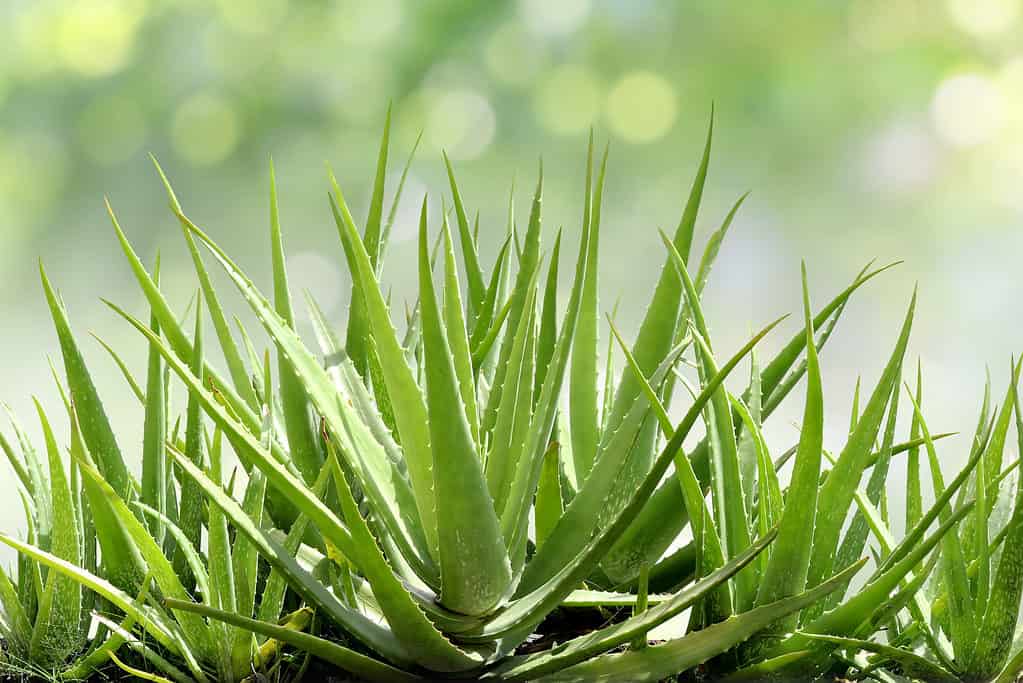
©iStock.com/cgdeaw
How Many Types of Aloe Succulents Are There?
There are more than 650 aloe types and they’re split into three groups:
- Tree aloes
- Shrub aloes
- Stemless aloes
Even though they look quite different they are all succulents and have very similar care requirements.
Here are some of the most popular types of aloe succulents:
Aloe vera
The best known of all the aloes. Its botanical name is Aloe barbadensis and it has stemless leaves that reach 15 inches tall. Its summertime flower spikes can reach heights of 35 inches and produce pinky-orange flowerheads.
Aloe vera was first described in 1753 by Carl Linnaeus as Aloe perfoliata var. vera. Vera which means “true” in Latin, but aloe history is much older. The Romans used aloe vera to treat wounds sustained in battle and childbirth.
There are many aloe vera different cultivars on the market such as ‘Red Aloe’ and ‘Gold Tooth’, but they are all stemless and contain medicinal gel.
Aloe arborescens
The torch aloe or candelabra aloe is native to South Africa, Mozambique, Zimbabwe, and Malawi.
It’s named after its tall, torch-like red flowers, but it also has succulent sword-shaped leaves and reaches 13 feet tall on a pseudo stem (a stem made from rolled leaf bases). It’s very popular in rockeries and yards prone to drought.
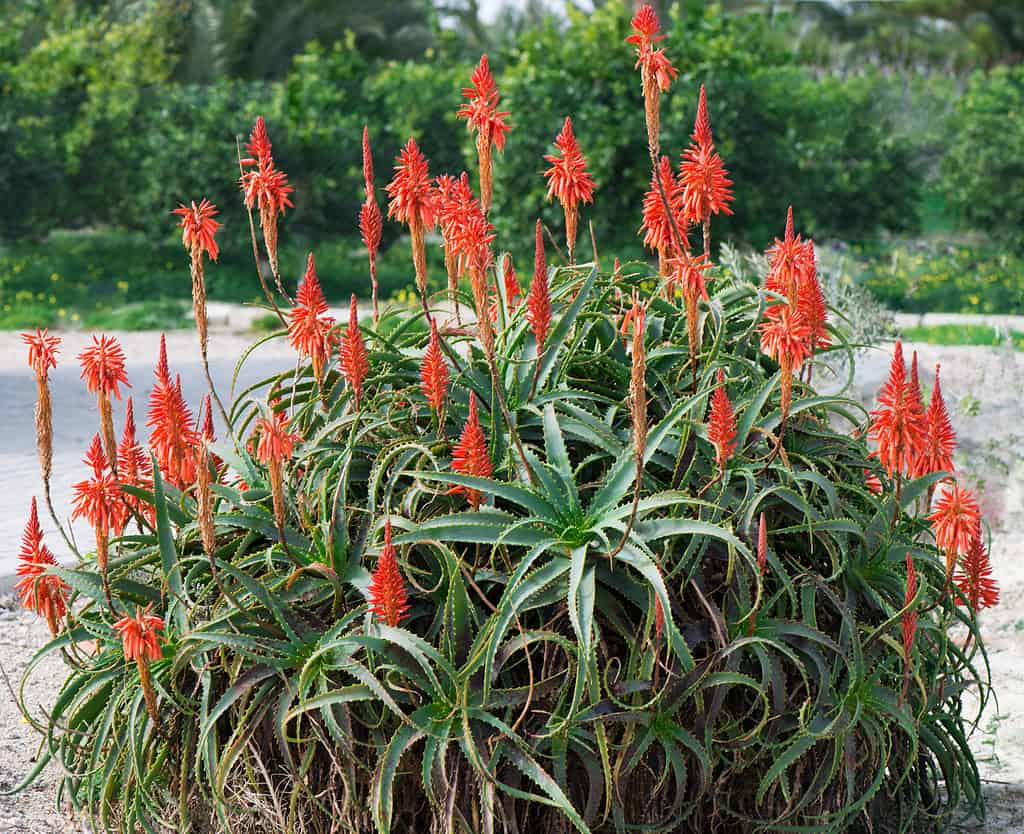
©iStock.com/Denira777
Aloe polyphylla
This pretty succulent aloe from South Africa forms a mesmerizing spiral with its sharp-tipped oval leaves and is quite stunning.
It usually reaches one foot in height and can spread over 1.5 feet. It’s another popular dry garden aloe, but younger spiral aloes are excellent houseplants too. However, its sap is poisonous and mustn’t be applied to skin.

©PhotoSky/Shutterstock.com
Aloe variegata
This dwarf aloe has many names including gonialoe aloe, tiger aloe, and partridge breasted aloe. It only reaches six to eight inches tall, so it’s a popular houseplant.
As it’s name suggests, this is a variegated mini aloe with thick fleshy green leaves specked and lined in white. It produces bright red flowers on a 12 inch stem in the hotter months, but even though it’s beautiful it is also toxic, so take care not to touch its sap.

©Irina Kvyatkovskaya/Shutterstock.com
Aloe ferox
Aloe ferox is a tree aloe with bright red or orange flower spikes that’s better known as the cape aloe or bitter aloe. It’ll reach almost ten feet in height in its native South Africa and arid back gardens.
It has thick green red-tinged leaves with small spines running along its margins that are filled with healing gel. It produces masses of gel so it’s widely used in industry.
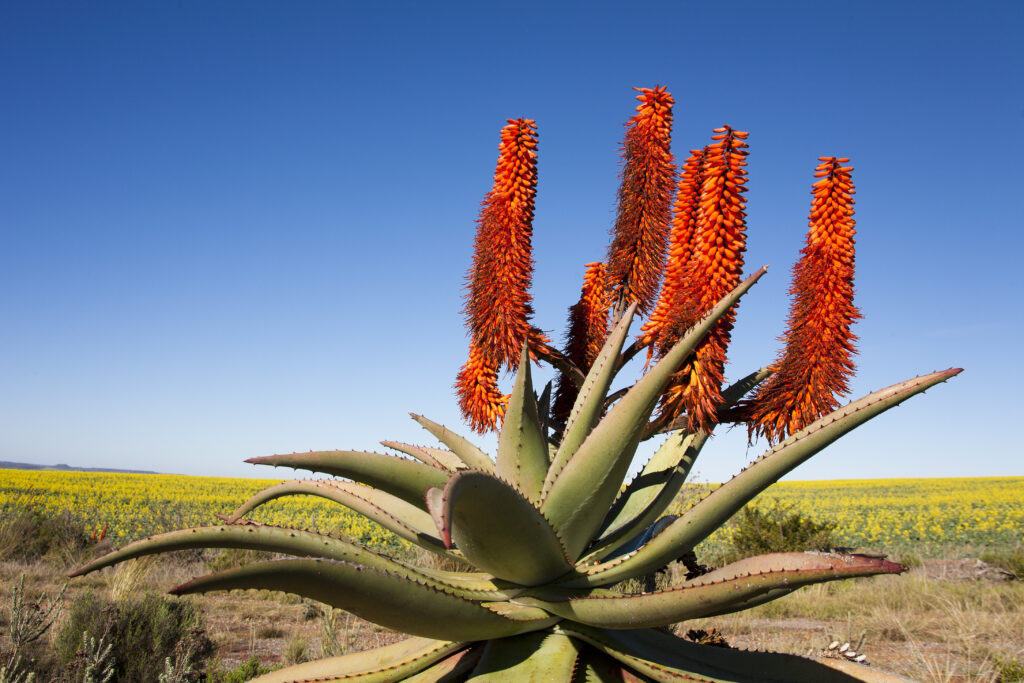
©Andrea Willmore/Shutterstock.com
Aloe mitriformis
This South African native aloe succulent is a type of dwarf aloe that forms a green rosette of red-tipped leaves studded with small cream spines.
It can reach several feet tall by creating itself a pseudostem, but it generally stays neat and compact, so it makes an excellent house succulent in a warm sunny spot. Its gel is not toxic and is used to treat some skin problems.
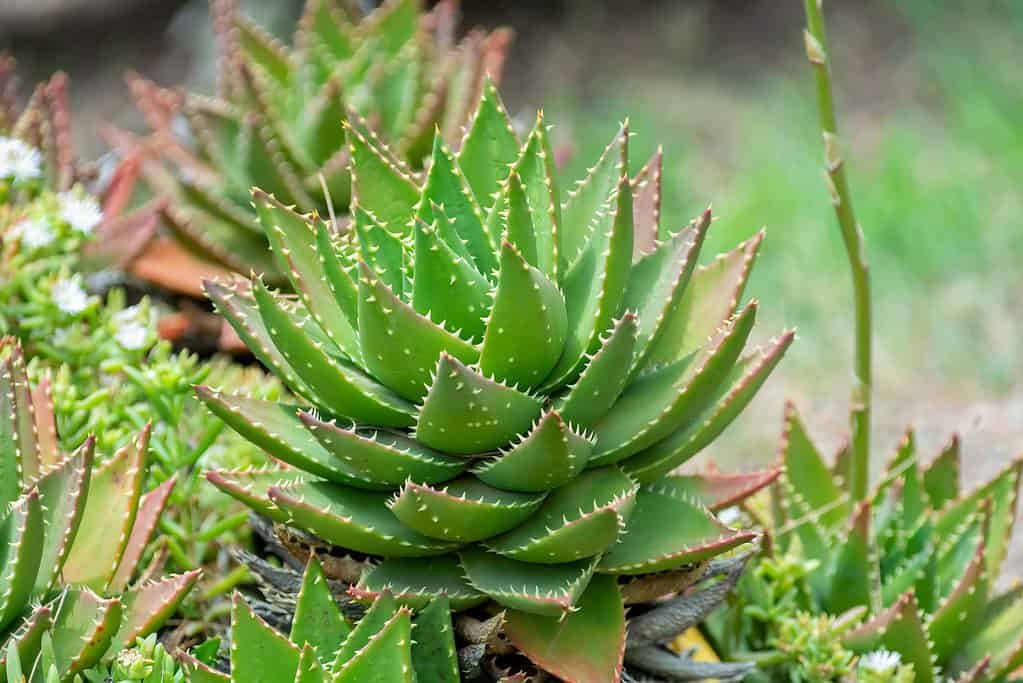
©iStock.com/daniele russo
Aloe plicatilis
Better known as the fan aloe, this is one of the tallest succulent aloes and no surprises here, it’s native to South Africa.
Fan aloes are capable of growing a pseudostem up to 16 feet tall and its thick, fleshy leaves sit like a fan on top. Mature aloe plicatilis grow several pseudostems with a fan crown and resemble small palm trees, so it’s a great choice for dry gardens.
In summer, a two to three feet long flower spike emerges with bright red flowers. It’s a stunning aloe succulent and a real talking point for the yard, however, its sap is toxic.

©onlyjayne/Shutterstock.com
Aloe aristate
This spherical aloe succulent is also called the guinea fowl or lace aloe because it has soft white-tipped spines.
It’s a small aloe without a stem that only reaches around six inches tall. Its thick fleshy leaves are serrated along the margins, tipped in burgundy, and in the warm months, it sprouts a shockingly orange flower.
Unlike aloe vera, this type of aloe is toxic and has no medicinal benefits.
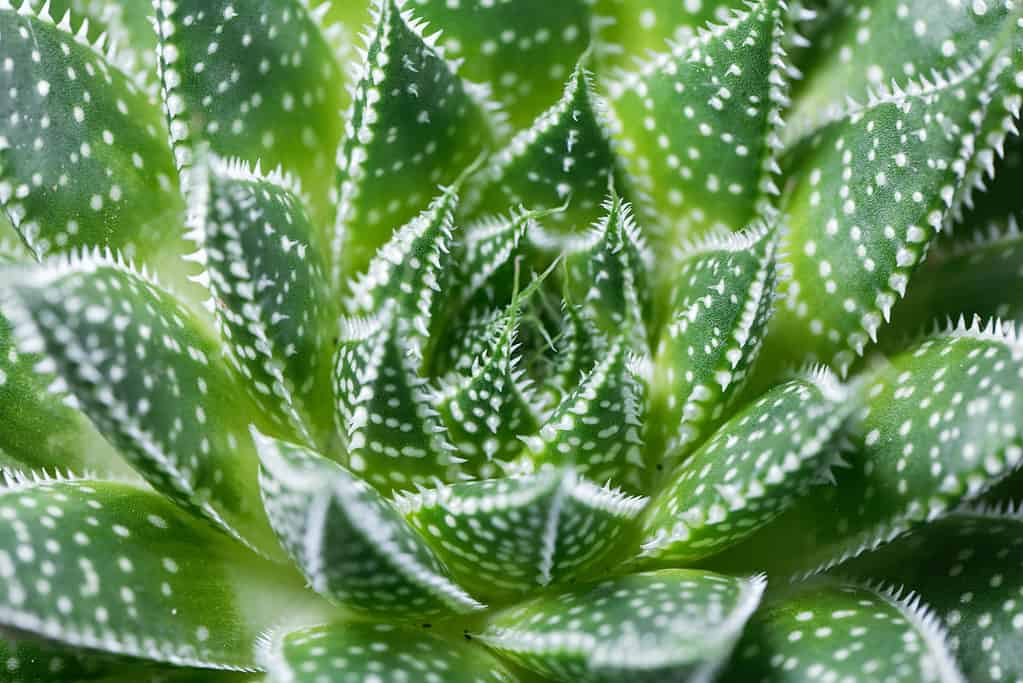
©ChWeiss/Shutterstock.com
Aloe aculeata
The red hot poker aloe is a very popular addition to hot and dry gardens and it’s easy to identify with its large rosette of fleshy green leaves with red-tipped margins.
Each leaf can reach up to two feet in length, but it’s the flower that wows people. This bright yellow flower blooms on a three to four feet tall stem and contrasts with its red teeth to look like the whole plant is on fire.

©Gail Euston-Brown/Shutterstock.com
How To Water and Feed Aloe Succulents
Less is more when it comes to caring for a succulent. They are hardy, independent plants that need little water or fertilizer.
Houseplant succulents need water when the container soil is dried out on top. Because water on the leaves can cause rot, it’s best to pop the inner pot in a sink of water and allow it to soak up what it needs for a few hours. After soaking, allow it to drain clear of excess water and wipe accumulated dust from its leaves.
In summer, you may need to water a succulent only once a fortnight, and in winter months can pass. Just keep an eye on its soil and finger test it for dryness once a week.
Fertilizer is only needed sparingly in a succulent’s growing season. Use a specific cactus and succulent fertilizer, because general purpose plant food is too rich.
Is Aloe Vera Good for Sunburn?
There’s not much clinical evidence that succulent gel is good for sunburn or other skin conditions, but it’s still found in a host of products including after-sun, skin lotion, cosmetics, and burn gels. Many people swear by its healing properties.
Why is my Aloe Succulent Going Brown?
Succulent aloes are drought and heat tolerant and they have the ability to go for weeks or months on end without water, but at the opposite end of the scale, too much water will cause a problem.
Aloes turn brown (or grey or purple) naturally as they shed their outer leaves, so if your aloe is just discolored on its outer foliage, peel it off and the problem is solved. However, if it browns in the crown or the inner leaves are off-color then it’s most likely overwatered or overfed.
Stop watering it, drain away any excess liquid, and let it dry out. You might be lucky and save it in time, but if the leaves have started to turn mushy, then it’s probably too late.
Another reason for browning aloe is sunburn. Houseplant succulents like a sunny window sill, but direct light magnified by a windowpane can scorch their fleshy leaves and create a rough, burnt patch.

©Adriana Marteva/Shutterstock.com
Is an Aloe Succulent a Cactus?
No, aloe succulents are succulents not cacti.
Succulent covers a wide range of plants from many families in the plant kingdom, but they all have water storage parts in common. This means a cactus is a succulent!
Types of Aloe Succulents: Which Are Best?
There are so many different types that choosing the best aloe succulent really comes down to its place in your home. Large tree succulents are excellent in dry gardens and dwarf aloes are perfect low-maintenance houseplants for a bright windowsill.
Up Next
- Gasteria vs. Haworthia: Key Differences to Know
- Sempervivum vs. Echeveria: What Are the Differences?
- Euphorbia vs. Cactus
The post Types Of Aloe Succulents appeared first on AZ Animals.
from Animal News, Facts, Rankings, and More! - AZ Animals https://ift.tt/7jleRmH